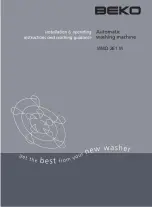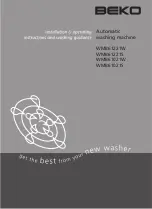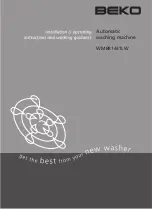
Notes on the motor
•
The normal operating speed of this sewing ma-
chine is 1,300 stitches per minute, which is quite
fast compared to the normal operating speed of
300 to 800 stitches per minute for the ordinary
foot-operated sewing machine.
•
The bearings in the motor are made of a special
sintered, oil-impregnated alloy mounted in oil-
soaked felt to withstand long hours of continuous
operation.
•
Continuous operation of the sewing machine can
cause heat to build in the motor area, but not
enough to adversely affect its performance.
It is important to keep fabric and paper away from
the ventilating holes on the back and sides of the
machine so air can get to these holes.
•
When the motor is running, sparks can be seen
through the ventilating hole in the motor bracket
on the side opposite the hand wheel. These
sparks are produced by the carbon brushes and
the commutator, and are part of the machines
normal operation.
CAUTION
WHEN THREADING THE MACHINE, RE-
PLACING A NEEDLE, OR WHEN THE MA-
CHINE IS NOT IN USE, WE RECOMMEND
DISCONNECTING THE ELECTRIC SUPPLY
PLUG TO AVOID ANY POSSIBLE HAZARDS.
NOTAS SOBRE EL
MOTOR
•
La velocidad normal de funcionamiento de esta
máquina de coser es de 1.300 puntadas por
minuto, lo que resulta bastante rápido compara-
do con la velocidad normal de 300 a 800 punta-
das por minuto de las máquinas de coser norma-
les que funcionan con pedal.
•
Los cojinetes del motor están hechos de una
aleación especial impregnada en aceite sintético
y montada en un fieltro impregnado en aceite,
para poder funcionar continuamente durante
muchas horas.
•
Un funcionamiento continuo de la máquina pue-
de contribuir a calentar algo la máquina en la
zona del motor, pero no lo suficiente como para
alterar su rendimiento y funcionamiento.
Sin embargo, es menester mantener los orificios
de ventilación de la parte trasera y en los lados de
la máquina sin tapar con tejido o papel durante el
uso, para que el aire pueda circular por los
orificios.
•
Durante el funcionamiento del motor, se pueden
ver chispas a través del orificio de ventilación de
la abrazadera del motor, en el lado contrario a la
ruedecilla. Estas chispas son producidas por las
escobillas de carbón que entran en contacto con
el conmutador, y forman parte del funcionamien-
to normal de la máquina.
PRECAUCION
Al enhebrar la máquina, cambiar una aguja o
al dejar la máquina sin usar, le recomenda-
mos desenchufar la máquina para evitar
cualquier peligro de corto circuito.
Содержание 925D
Страница 1: ...NDBOOK FOR COMPACT ERLOCK MACHINE NUAL DE INSTRUCCIONES DE LA QUINA COMPACTA OVERLOCK 5 4 5 4 5 4 5 4 ...
Страница 33: ...26 5 1 2 3 5 7 4 6 8 7 8 1 5 4 1 2 3 2 ...
Страница 35: ...28 5 1 2 3 5 7 4 6 8 7 8 8 7 4 3 1 5 4 1 2 2 1 ...
Страница 73: ......






































